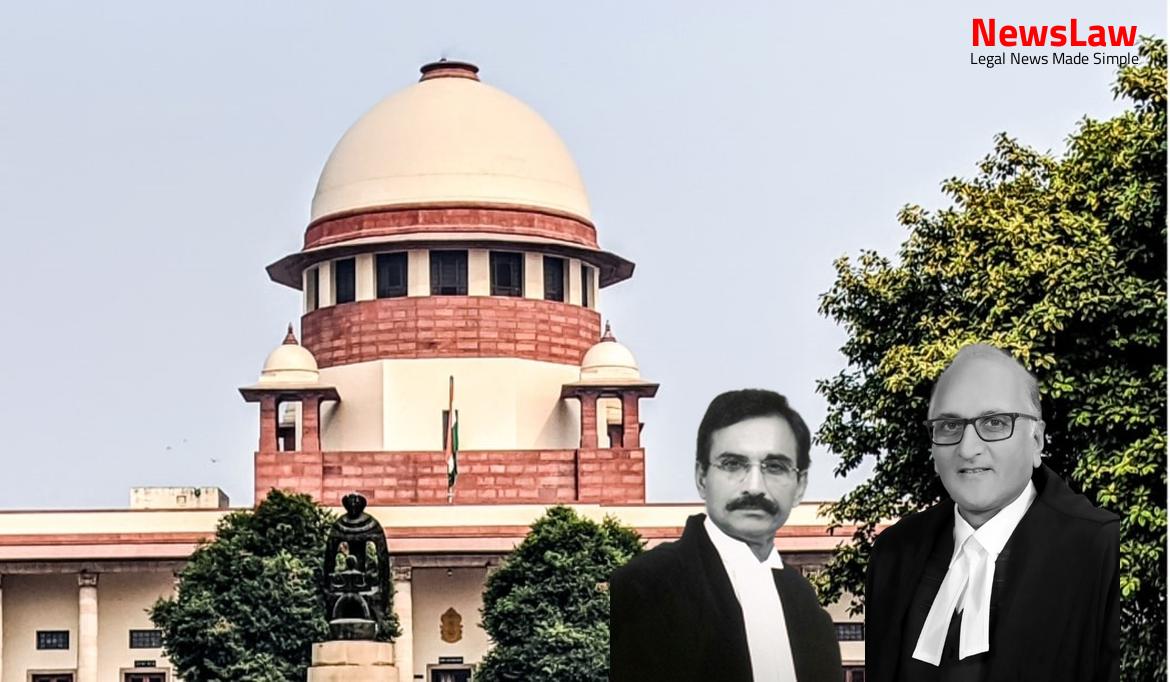Delve into the legal intricacies of a recent court case highlighting environmental protection and regulatory jurisdiction. The court’s analysis delves into issues of responsibility, accountability, and the interpretation of regulatory powers. Discover how the court navigates complex legal frameworks to uphold justice and address environmental concerns effectively.
Facts
- NHAI entered into an agreement with M/s P.S. Toll Road (Pvt.) Ltd. for maintenance and operation of the Pune-Satara section of National Highway No. 4.
- The agreement included construction, operation, and maintenance for a period of 24 years.
- The agreement mandated safety measures for highway users and allowed NHAI to recover damages if remedial measures were not taken.
- NHAI pointed out large-scale excavation near New Katraj Tunnel and warned of potential hazards like tunnel collapse due to water seepage.
- Despite knowledge of excavation activities, NHAI remained silent for about two years.
- The license for mineral extraction was granted by the government to the respondents.
- The case involves appeals before the court challenging regulations framed as per NGT’s order by various parties.
- The Sub-Divisional Magistrate conducted an inquiry into the incident, appointed an expert, and considered reports after visiting the site and holding hearings.
- The incident involved destruction caused by hill cutting near the highway resulting in fatalities and legal actions against the respondents.
- The appeals before the court deal with the directions issued by the NGT bench in Pune based on an application by the Aam Aadmi Lokmanch.
- NGT justified the imposition of liability on Rathod for illegal activities
- The state had imposed fines and penalties for these activities
- NGT emphasized Rathod’s role in the illegal activities
Also Read: Legal Analysis of Claim for Loss of Profit in Delayed Contract
Arguments
- NHAI and other appellants argue against the directions issued by the NGT, stating they are illogical and not based on scientific analysis.
- The appellants challenge the NGT’s authority to issue sweeping directives against all building activities near hill slopes.
- Rathod argues that the NGT’s findings against him are contrary to law and the state’s actions went against MRTP Act procedures.
- Illegal hill destruction was widespread, and Rathod’s actions were deemed too remote to hold responsibility for the tragedy.
- NHAI contests being held liable for the incident, highlighting their prior communications about illegal activities to local authorities.
- The appellants assert that the NGT did not consider relevant parties and evidence before issuing directions and compensation orders.
- The Lokmanch supports NGT’s orders and blames NHAI, Rathod, and state government for negligence in preventing the tragedy.
- The appellants argue that the NGT’s directions were the basis for state government notifications, contrary to established town planning principles.
- The NGT’s jurisdiction to issue compensation orders is questioned by the appellants, especially without direct applications from legal representatives of the deceased.
- NHAI disclaims responsibility for the tragedy and faults state authorities for inaction, highlighting the NHAI’s lack of culpability in the incident.
- Counsel argued that the provision in question was amended in 2015, and since there was no challenge to it, the exercise of power after considering relevant factors should be upheld.
- The jurisdiction to issue general directions for environmental preservation and protection is provided in Section 15(1)(c) of the NGT Act.
- The State contends that the Bombay High Court’s judgment correctly supported the exercise of regulatory power under Section 154 of the MRTP Act.
- The power and jurisdiction to order compensation in death cases are independent and can be invoked in fatal accidents, as per the provisions of Schedule II.
- Reference was made to the case of Hanuman Laxman Aroskar v. Union of India to support the arguments.
- The State of Maharashtra backed the arguments put forth by Lokmanch.
Also Read: Public Declaration Requirement in Marriage under Hindu Marriage Act
Analysis
- NGT Act provides the Tribunal with primary and appellate jurisdiction.
- The primary jurisdiction under Sections 14-15 allows the Tribunal to settle disputes involving substantial environmental questions.
- Relief, compensation, and restitution can be awarded by the Tribunal under the specified enactments.
- The Tribunal has the power to grant relief and compensation to victims of pollution and environmental damage.
- Applications for compensation or relief must be filed within five years from the date the cause of action arose.
- The Tribunal may divide compensation under separate heads as deemed appropriate.
- The Act gives the Tribunal appellate jurisdiction to hear appeals on various environmental issues.
- The Act allows the Tribunal to have overriding effect over other laws in matters within its jurisdiction.
- Public authorities are generally subject to the same liabilities in tort as private individuals and bodies
- Statutory negligence is independent of any other form of tortious liability
- Environmental protection requires choices on the appropriate level of protection and regulated risks
- The allowance of call drops per month under regulations affects fundamental rights of appellants
- Service providers’ fault must be proven for severe inconveniences to consumers
- Legal responsibility of the owner is irrespective of knowledge of danger
- The agency may not have had sufficient experience to form rigid rules
- Officials are under the same responsibility as any other citizen for acts without legal justification
- The judge held that the owner’s failure was a cause of the accident
- There is no duty of care in private law based on statutory duty
- Public authorities generally under a duty of care to avoid causing actionable harm
- NGT has the legal obligation to provide preventive and restorative measures for the environment
- Parliament has control over the regulation of mines and development of minerals
- Universal human dependence on environmental resources necessitates alteration
- Administrative orders must be based on reasons even if natural justice principles are not complied with
- The concept of sustainable development emphasizes conserving natural resources
- Public authorities generally owe no duty of care to prevent harm unless specific circumstances apply
- NGT has jurisdiction to appoint committees and experts for environmental justice
- NGT’s jurisdiction is based on remedial and preventive measures for the environment
- NGT exercises appellate jurisdiction over regulatory bodies and original jurisdiction
- Courts have struggled with issues arising from regulatory adjudication
- Delegated powers must be exercised in good faith, reasonably, and on relevant considerations
- Public authority’s negligence can lead to damages if a duty to act was breached
- Duty of care by an authority arises from creating the danger
- Highway authorities have an absolute duty to maintain the road to ensure safety
- Regulatory interpretation can be established through specific orders rather than general regulations
- The directive of 14.11.2017 by the State of Maharashtra lacked reasons and was solely based on the directions of the NGT in Para 17(e)
- The NGT directions and the subsequent state notification were not supported by scientific evidence or technical expert reports
- The notification did not provide clarity on what constitutes ‘hills’ and its applicability in different geographic settings
- The directions were vague and could be arbitrarily applied by authorities, leading to blanket changes in regional and development plans
- The absence of reasons and expert input rendered the directive an arbitrary exercise, lacking intelligent care and deliberation
- The directive was issued without proper justification or consideration, solely based on the NGT’s orders, indicating a lack of application of mind by the State
Also Read: OCI Cardholders’ Rights and Retroactive Notifications
Decision
- Respondent Nos. 5, 6, and 9 to jointly and severally pay Rs. 15 Lakhs as compensation to the legal representatives of deceased Mrs. Vishakha Vadekar.
- The appeals by third parties against the NGT’s order partly allowed as per the terms mentioned.
- The notification under Section 154 dated 14.11.2017 is quashed with further directions given.
- Respondent Nos. 5, 6, and 9 directed to pay a joint penalty of Rs. 50 Lakhs for causing environmental damage due to hill-cutting in the Katraj area.
- The penalty amount to be deposited with the Collector (Pune) within six weeks, failing which it can be recovered as arrears of Land Revenue.
- The deposited amount to be put in a special escrow account by the Collector for environmental protection and conservation activities, including hill protection and conservation in the district.
- The cases CA 6932/2015 and CA 5971/2019 are disposed of in line with the directions given in this judgement.
Case Title: DIRECTOR GENERAL (ROAD DEVELOPMENT) NATIONAL HIGHWAYS AUTHORITY OF INDIA Vs. AAM AADMI LOKMANCH . (2020 INSC 452)
Case Number: C.A. No.-006932-006932 / 2015



